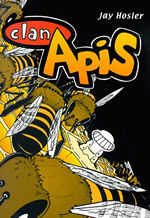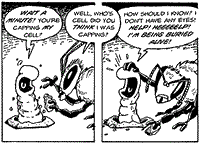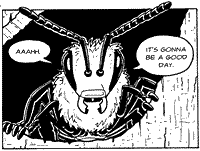>> The Friday Review: The Tale Of One Bad Rat
>> The Friday Review: Cathedral Child
More...

 Writer/Artist: Jay Hosler
Writer/Artist: Jay Hosler
Letters: Rich & Saida at Comicraft
Tradepaperback published by Active Synapse (2000)
Price: $15
ISBN: 0-9677255-0-X
Website: www.jayhosler.com/clanapis.html
Don't you just hate it when a review describes something as being a "genuinely fresh and unique concept", only for it to turn out to me more of the same? Me too. Which is why I'm a little reluctant to start this review with just that assertion, but, quite honestly, CLAN APIS really is a unique piece of work.
Still with me? Good.
CLAN APIS sets out to tell the tale of a colony of bees - the Clan Apis - or more specifically, the life story of one particular bee called Nyuki. The reader first encounters Nyuki in her larval stage, being told the story of "The World Flower" by her elder sister Dvorah. The story is the insect's religion, and sets the scene that insects were the first land life and that they outnumber all other animals on the planet. Nyuki then describes the whole World Flower concept as the "Big Bloom Theory" and the tone of the work is set: serious educational points interspersed with humour and groan-inducing puns!
After Nyuki hatches, we follow her through her first days in the hive, in which she meets the Queen and chooses to follow her to establish a new hive. Along the way, Nyuki dices with death at the hands (OK, mandibles) of a Preying Mantis and a Spider, makes friends with a Dung Beetle and a flower called Bloomington, and generally gets her first introduction to the fairly daunting world outside the safety of the hive.
As we are following Nyuki through her full lifecycle, we see her grow into a full fledged member of the clan, and eventually die. Prepare to get a little misty eyed as at this point as our heroine has been so full of life and genuinely endearing all the way through the story. However, it's also a fairly optimistic scene as Hosler invokes the whole "circle of life" concept, though - thankfully - without any over-the-top LION KING-style melodramatics.
 What makes CLAN APIS unique is that it sets out to be educational, but does this by means of telling an entertaining story, as opposed to telling a story that also educates. While - for example - AGE OF BRONZE has a mass of information about the ancient Trojans and their wars, I don't think that Eric Shanower set out specifically and primarily to educate his audience. Others, from Frank Miller's 300 to Alan Moore's BROUGHT TO LIGHT, are tremendously informative, but remain as informative retellings of historical events rather than as original stories in their own right. Given all the complimentary reviews I had read of CLAN APIS, I was fully expecting something that would be impressively crafted and full of facts. What I didn't necessarily expect was a thoroughly engaging story that I couldn't put down until I'd finished.
What makes CLAN APIS unique is that it sets out to be educational, but does this by means of telling an entertaining story, as opposed to telling a story that also educates. While - for example - AGE OF BRONZE has a mass of information about the ancient Trojans and their wars, I don't think that Eric Shanower set out specifically and primarily to educate his audience. Others, from Frank Miller's 300 to Alan Moore's BROUGHT TO LIGHT, are tremendously informative, but remain as informative retellings of historical events rather than as original stories in their own right. Given all the complimentary reviews I had read of CLAN APIS, I was fully expecting something that would be impressively crafted and full of facts. What I didn't necessarily expect was a thoroughly engaging story that I couldn't put down until I'd finished.
The technique that really makes CLAN APIS succeed is the choice of Nyuki as the main focal character. A pet hate of mine is stories where two characters who already know a topic inside-out suddenly start discussing that topic in very basic terms so as to get a point across to the reader. Since Hosler has an enormous amount of information to impart in CLAN APIS, it could easily have degenerated into a dry unreadable mass of talking bees.
But since Nyuki is learning herself, and is written to have a naturally inquisitive nature, the information comes across as an organic part of the story. In the trade paperback there are also a number of pages at the back with a wealth of further reading. Moving this out of the narrative allows the story to flow, with minimal "author intervention" from captions or stilted exposition, while still carrying enough information to - hopefully - intrigue the reader sufficiently for them to do the follow-up reading at the end of the story.
Another nice touch is that way that, in addition to the word Apis itself being latin for "Bee", all Nyuki's hivemates are named after the actual word for bee in various languages. So as well as Nyuki's own name being Swahili, we get names like Aeja (Spanish) and Dvorah (Hebrew) and again, the reader is learning something almost without realising it. The names are exotic and evocative enough to be distinctive, and it's quite easy to tell one bee from another. Which might not have been the case had Hosler chosen to go for an overly dramatic DANCES WITH WOLVES style riff. "Stings During Picnics" and "Scares Girlfriend In The Shower" don't have quite the same ring to them.
 CLAN APIS is also refreshing, in that it doesn't treat children (who are, after all, the main intended audience) as precious little mites who must be protected from harsh reality at all costs. The casual brutality of Mother Nature is depicted here in all its glory, quite apart from Nyuki's near-death-experiences with the Preying Mantis and the Spider. For instance, there's a matter-of-fact description of how the first newborn Queen in a hive must sting all her sisters to death, and how the old Queen must leave pretty sharpish to avoid forcing the new firstborn into a death match with her mother. Add in the fairly grisly death of a marauder from another clan (smothered by the multiple bodies of the Apis defenders until he dies from overheating) and it becomes obvious that Hosler knows how kids like a bit random slaughter now and again. The average five year old in my experience bears far more resemblance to Calvin (of CALVIN AND HOBBES fame) than to the darling little cherubs that the media is prone to portraying them as.
CLAN APIS is also refreshing, in that it doesn't treat children (who are, after all, the main intended audience) as precious little mites who must be protected from harsh reality at all costs. The casual brutality of Mother Nature is depicted here in all its glory, quite apart from Nyuki's near-death-experiences with the Preying Mantis and the Spider. For instance, there's a matter-of-fact description of how the first newborn Queen in a hive must sting all her sisters to death, and how the old Queen must leave pretty sharpish to avoid forcing the new firstborn into a death match with her mother. Add in the fairly grisly death of a marauder from another clan (smothered by the multiple bodies of the Apis defenders until he dies from overheating) and it becomes obvious that Hosler knows how kids like a bit random slaughter now and again. The average five year old in my experience bears far more resemblance to Calvin (of CALVIN AND HOBBES fame) than to the darling little cherubs that the media is prone to portraying them as.
Hosler's art style is cartoony in nature, which fits the story fine. A more "realistic" style wouldn't jibe naturally with talking insects, and it allows him to play down the backgrounds to give the characters room to manoeuvre outside the confines of the hive. Besides, he'd probably have gone blind and/or insane trying to draw half a million bees in an ultra-detailed Bryan Talbot or George Perez style!
The cartoon-like nature also allows Hosler to pull off a few neat little tricks to help the story along, such as having Nyuki's antenna form into exclamation or questions marks when startled or puzzled during some of the more exposition heavy sequences. Another trick is that Dvorah has a broken antenna, which allows a natural mention in the story of how bees "smell" through their antenna, but also provides a visual clue as to which bee amongst the multitude actually is Dvorah.
Hosler also plays around with the page layout to good effect from time to time, including some nice pages where the shape of the panels shifts into a honeycomb lattice to mimic the nature of a beehive. There's also a particularly effective sequence when Nyuki is hatching from her larval form, and the panels are shaped into a series of hexagons to represent her birth chamber as she's reborn.
DID YOU KNOW?
CLAN APIS was created with financial help from
the Xeric Foundation,
a nonprofit organisation that has also helped such varied and
critically acclaimed titles as JAR OF FOOLS (Jason Lutes), CASTLE
WAITING (Linda Medley) and VOX (Leland Purvis).
Probably the best way to decide if CLAN APIS is for you is to visit Hosler's CLAN APIS website, which features sixteen pages from the story. It's worth noting that, although the site makes mention of a sequel series - INTREPID FORAGER - focusing on Nyuki's younger sister Melissa, a forager bee from CLAN APIS, this series has actually been abandoned. Hosler does have another untitled piece tentatively scheduled for late 2001/early 2002 though, which apparently features such diverse elements as follicle mites and Darwin.
Finally, just in case anyone doubts the educational efficacy of a funny comic book, a real world story to finish with. A couple of months ago I was filling in a crossword puzzle, and one of the clues was asking for the Greek word for "Bee". Despite it being at least six months since I read CLAN APIS, I knew the answer.
CLAN APIS is a delightful piece of work - an engaging and easy to read story, educational without hammering the point home and genuinely funny in places. Thoroughly recommended for anyone with inquisitive children, anyone who's retained their own love of finding out about the world around them purely for the sake of it, and anyone who just plain wants to find out what the Greek word for "Bee" actually is.

This article is Ideological Freeware. The author grants permission for its reproduction and redistribution by private individuals on condition that the author and source of the article are clearly shown, no charge is made, and the whole article is reproduced intact, including this notice.


